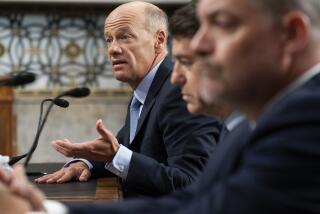POLITICS / S&L; CRISIS : No Clear-Cut Partisan Victor Emerges in Ongoing Scandal : Democrats hope to capitalize on the issue in the upcoming congressional elections, but Republicans are fighting back.
- Share via
PORTLAND, Ore. — The savings and loan scandal is fast emerging as the most contentious issue of the 1990 congressional campaign.
Recalling how Iran-Contra took the steam out of the Ronald Reagan presidency, and Watergate drove Richard M. Nixon from the White House, Democrats are hoping the multibillion-dollar banking fiasco will be an economic replica of those momentous miscues.
But this time the Republicans are determined to hit back, and they have plenty of ammunition.
For example, Democrats planned to use their executive committee and state chairs meeting here last weekend as a venue for a blast by national party Chairman Ron Brown at Bush on the savings and loan issue. But before Brown could deliver his speech lambasting Bush’s “total bungling” of the crisis by paying off uninsured depositors and failing to prosecute savings and loan malefactors, the Republicans struck.
Reporters here found their hotel mailboxes stuffed with copies of a press release from Mary Matalin, Republican National Committee chief of staff, scolding the Democrats for pointing “fingers of blame” while the President “has been rolling up his sleeves,” trying to solve the crisis. Matalin, who has been standing in for fiery GOP Chairman Lee Atwater during his battle against brain cancer, named 10 Democratic lawmakers as “violators of the public trust” because they had received substantial contributions from and/or had done favors for the savings and loan industry.
The GOP fired its first salvo two weeks ago. White House Press Secretary Marlin Fitzwater ticked off the names of Democratic lawmakers who received big contributions from the savings and loan industry. Fitzwater also blamed much of the current mess on the increase in the limit on federal deposit insurance, enacted in 1980 by a Democratic Congress at the behest of the industry and signed into law by Democratic President Jimmy Carter.
Some Democrats concede that the savings and loan issue may not be a bonanza for the party. “I don’t think you can draw a clear line of partisan responsibility,” says Democratic Gov. Richard F. Celeste of Ohio, who as he finishes his second term in the Columbus Statehouse is seen as a possible 1992 presidential candidate.
“I think it is mainly an anti-Washington issue for an outsider candidate to use,” says Democratic pollster Stanley Greenberg. He points out that most Democratic candidates in this fall’s congressional races are not “outsider” challengers but “insider” incumbents.
But Democratic National Committee political director Paul Tully contends that most of his party’s candidates will have an advantage because of the difference in the public perception of the two major parties. Tully cites a recent survey by pollster Greenberg in which 53% of those interviewed named the Republicans as the party that “pays too much attention to the lobbyists, the rich and people with power,” compared to only 16% who named the Democrats.
Even so, Ohio’s Celeste does not think individual Democratic candidates can safely rely on such generalized perceptions. “I think we as Democrats need to offer aggressive alternatives for dealing with the problem,” he said. Celeste speaks with some authority on the subject, having won reelection after grappling with a savings and loan crisis in his own state back in 1985. Among Celeste’s recommendations: capping the number of savings and loan accounts an individual depositor can have covered by federal insurance and appointment of a special prosecutor to clean up the current mess.
More to Read
Get the L.A. Times Politics newsletter
Deeply reported insights into legislation, politics and policy from Sacramento, Washington and beyond. In your inbox twice per week.
You may occasionally receive promotional content from the Los Angeles Times.










